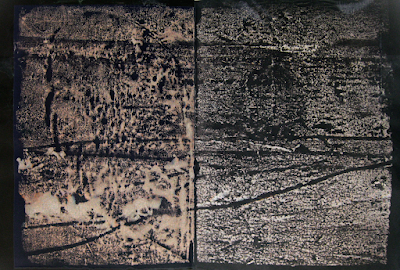
Footprint on the Moon
July 1969, Armstrong and Aldrin step out of the lunar capsule and onto the surface of the Moon. Their landing place is the Sea of Tranquility. Aldrin describes the landscape as ‘magnificent desolation’. It is an immaculate surface: trackless, uninterpreted.
In slow motion their feet sink into a shallow layer of dust, compressing the dry particles to leave an impression. The moment has gravity. This fine dust has no relation to the moon rock below, it has been deposited by the impacts of asteroids and meteors. It is the debris of shooting stars, the fall-out of portents and warning signs. It presents a perfect recording surface. The ground of an image.
There is no wind or rain on the moon, no tide or breath to take this fragile footprint away. We cannot cover our tracks. We measure our months by the moon but this small step onto its surface leaves a mark in the vastness of cosmological time. The imprint endures as cities fall and continents shift. It will remain longer than the cave paintings, those ochre handprints which mark out the earliest trace of what it is to be human. Imprints are potent. Remember Robinson Crusoe’s shock at finding a footprint in the sand of his desert island. He is thunderstruck, fearful, as if he had seen an apparition. The affect of presence from these traces of absence is profound. We are haunted.
Buzz Aldrin photographs the imprint of his boot on the lunar surface with a 70mm Hasselblad camera. The image of the footprint is transferred to film by the action of light onto a sensitive surface; a trace of a trace. Image of an index. The photographic image is evidence to be measured, scrutinised, magnified: a scientific souvenir and a political emblem. This extraterrestrial image is proof of landfall.
Ted Kaczynski, the Unabomber, fabricated a pair of shoes with the soles of smaller sneakers attached. His purpose was to leave a false trail. It is an echo of the confusion Hercules felt on seeing the track of his stolen oxen leading in one direction but hearing their bellows from another. The thief had forced the animals backwards.
In December I saw the trail of a rabbit in the deep snow. The spoor ended abruptly in the middle of the field. Around the final footprints the traces of two broad wings were beaten into the snow, the feather tips distinct. Rabbit and buzzard assembled into a simple endgame or a composite beast?
Back down to Earth, Aldrin’s film is stored in a freezer. Later it is digitsed. The scan is an ambivalent form, reading an image as object, shifting categories back and forth. Information is packed into file formats. Image becomes code. In the form of zeros and ones the print propagates easily; accelerating into the space of exchange; our virtual common ground. There it multiplies, transforms, leaks information, becomes noise, returns to stardust.

















